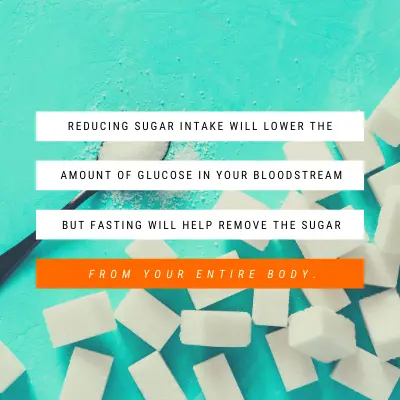Diabetes is thought to be one of the fastest-growing epidemics of the 21st century, which is particularly alarming because it’s not only preventable, but it’s also treatable and even curable once you’ve been diagnosed. Sadly, a diagnosis often comes the belief that it’s a chronic, progressive disease that can be managed, but will stay with you for life. This is just not true and in this article, we’re going to discuss how fasting for diabetes can literally save your life.
Can Diabetes Be Reversed
Before we discuss possible cures, it’s important that we all understand the difference between type 1 and type 2 diabetes.
Your body runs on glucose, which is sugar, so the calories you eat are converted into glucose which runs through your blood to be delivered to the various cells in your body. When you have enough sugar in your bloodstream to supply your body with all the energy needed to keep you functioning and alive, the hormone insulin tells your cells to start taking the glucose out of your bloodstream and storing it for later use in your cells.
If you consistently have too much sugar in your blood, a condition known as hyperglycemia, over time it can cause nerve and organ damage and even be fatal. We all need well-regulated insulin to survive.
Type 1 vs Type 2 Diabetes
Type 1 diabetics have a physiological problem in which their pancreas doesn’t produce enough insulin to regulate their blood sugar naturally. Currently, we don’t know exactly what causes type 1 diabetes and there is no cure, only symptom management.
Type 2 diabetics, on the other hand, began with a pancreas that functioned well and produced the appropriate amount of insulin to maintain health.
If the cells in your body start to ignore, or resist, insulin’s directions on storing excess sugar, you will start to have chronically high levels of blood glucose. This is called insulin resistance. Your pancreas will be forced to produce more and more insulin to manage your blood sugar until finally it is tapped out and cannot produce enough insulin any longer. This is when you’ll be diagnosed with Type 2 diabetes.
Most people believe that, at this point, their only option is to turn to mediation to supplement their body’s demand for insulin. Taking insulin may help manage your blood sugar levels so that you survive, but it will also progressively make your diabetes worse as your resistance to insulin increases.
There is a second option, however, and it has a much more promising outcome. You can reduce your demand for insulin and help your body’s natural biological systems start communicating effectively again, reversing your type 2 diabetes.
How to Reverse Insulin Resistance
For many years, it was believed that obesity caused diabetes and a diet high in fat and low in exercise caused obesity. Experts on the subject today look at the disease with a fresh perspective. Though there is still a lot of controversy on the subject, we do know that if you can regulate the glucose in your body you can absolutely reverse your insulin resistance and therefore type 2 diabetes.
The first step is to stop adding refined sugars and processed simple carbohydrates to your blood through the foods you eat. You can try to exercise more to burn off more sugar but that, again, is treating a symptom instead of addressing the problem of too much sugar. Starting a low carb, and therefore low sugar, diet will help reduce the sugar in your blood, but if you’re insulin resistant it won’t necessarily repair your insulin response.
Treating vs Healing
Fasting is the most efficient and effective way possible to naturally control insulin. If you stop eating for a period of time, your body won’t have access to the easy, free-flowing sugar you’ve been feeding it for years. It won’t just stop working though; it takes a long time for a person to starve to death. Instead, your body will be forced to draw on the stored sugar that insulin has been tucking away for a rainy day: your adipose tissue, or fat.
Reducing sugar intake will lower the amount of glucose in your bloodstream but fasting will help remove the sugar from your entire body. By doing so, you will not just lose weight, but you’ll repair your insulin response and reverse your diabetes.
Fasting should always be paired with a healthy, nutrition-packed diet. It is in no way a license to ignore the nutritional needs of your body. If you decide to try fasting, it’s crucial that you properly support your body with all the nutrition required to run effectively, before and after you fast. This means plenty of colorful fruits and vegetables, whole grains and lean proteins and as little processed carbohydrates and refined sugars as possible.

Reverse Your Diabetes With Fasting
If you’re new to fasting you should always work with a professional to make sure you’re safe throughout the process, especially if you’re currently taking medication to regulate your blood glucose levels. However, many studies have shown significant improvements in markers of type 2 diabetes in fasts as short as 24 hours.
This isn’t an overnight miracle cure, but strategic fasting might be your ticket to diabetic remission over time. Diabetes is a complicated and controversial disease and there’s no way we can cover everything about reversing your condition in one simple article. However, hopefully, you now at least have hope that:
- Type 2 diabetes can be completely reversed, without medication,
- The most effective natural treatment for insulin resistance is fasting, and
- A life without excess refined sugar is much more enjoyable and healthful than a life controlled by diabetes medications
Diabetes is not the only so-called chronic disease that can be reversed by strategic fasting. Making fasting part of your lifestyle is one of the healthiest overall habits you can adopt to improve your quality of life now and for the rest of your future. If you’ve read this far, you’ll probably enjoy the related post, Is Fasting Healthy, which will answer a lot more of your fasting questions.



